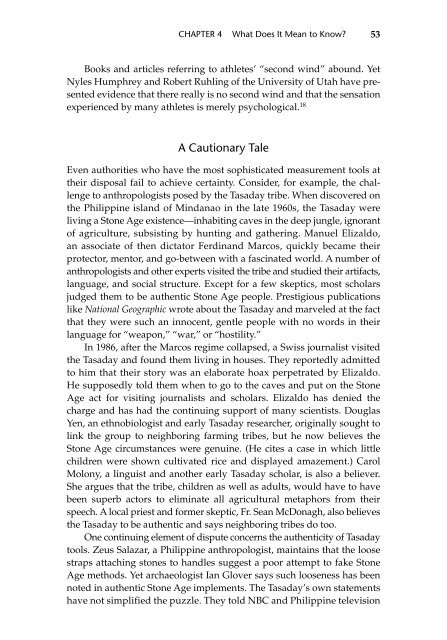Beyond Feelings
Beyond Feelings
Beyond Feelings
You also want an ePaper? Increase the reach of your titles
YUMPU automatically turns print PDFs into web optimized ePapers that Google loves.
CHAPTER 4 What Does It Mean to Know?<br />
Books and articles referring to athletes’ “second wind” abound. Yet<br />
Nyles Humphrey and Robert Ruhling of the University of Utah have presented<br />
evidence that there really is no second wind and that the sensation<br />
experienced by many athletes is merely psychological. 18<br />
A Cautionary Tale<br />
Even authorities who have the most sophisticated measurement tools at<br />
their disposal fail to achieve certainty. Consider, for example, the challenge<br />
to anthropologists posed by the Tasaday tribe. When discovered on<br />
the Philippine island of Mindanao in the late 1960s, the Tasaday were<br />
living a Stone Age existence—inhabiting caves in the deep jungle, ignorant<br />
of agriculture, subsisting by hunting and gathering. Manuel Elizaldo,<br />
an associate of then dictator Ferdinand Marcos, quickly became their<br />
protector, mentor, and go-between with a fascinated world. A number of<br />
anthropologists and other experts visited the tribe and studied their artifacts,<br />
language, and social structure. Except for a few skeptics, most scholars<br />
judged them to be authentic Stone Age people. Prestigious publications<br />
like National Geographic wrote about the Tasaday and marveled at the fact<br />
that they were such an innocent, gentle people with no words in their<br />
language for “weapon,” “war,” or “hostility.”<br />
In 1986, after the Marcos regime collapsed, a Swiss journalist visited<br />
the Tasaday and found them living in houses. They reportedly admitted<br />
to him that their story was an elaborate hoax perpetrated by Elizaldo.<br />
He supposedly told them when to go to the caves and put on the Stone<br />
Age act for visiting journalists and scholars. Elizaldo has denied the<br />
charge and has had the continuing support of many scientists. Douglas<br />
Yen, an ethnobiologist and early Tasaday researcher, originally sought to<br />
link the group to neighboring farming tribes, but he now believes the<br />
Stone Age circumstances were genuine. (He cites a case in which little<br />
children were shown cultivated rice and displayed amazement.) Carol<br />
Molony, a linguist and another early Tasaday scholar, is also a believer.<br />
She argues that the tribe, children as well as adults, would have to have<br />
been superb actors to eliminate all agricultural metaphors from their<br />
speech. A local priest and former skeptic, Fr. Sean McDonagh, also believes<br />
the Tasaday to be authentic and says neighboring tribes do too.<br />
One continuing element of dispute concerns the authenticity of Tasaday<br />
tools. Zeus Salazar, a Philippine anthropologist, maintains that the loose<br />
straps attaching stones to handles suggest a poor attempt to fake Stone<br />
Age methods. Yet archaeologist Ian Glover says such looseness has been<br />
noted in authentic Stone Age implements. The Tasaday’s own statements<br />
have not simplified the puzzle. They told NBC and Philippine television<br />
53


